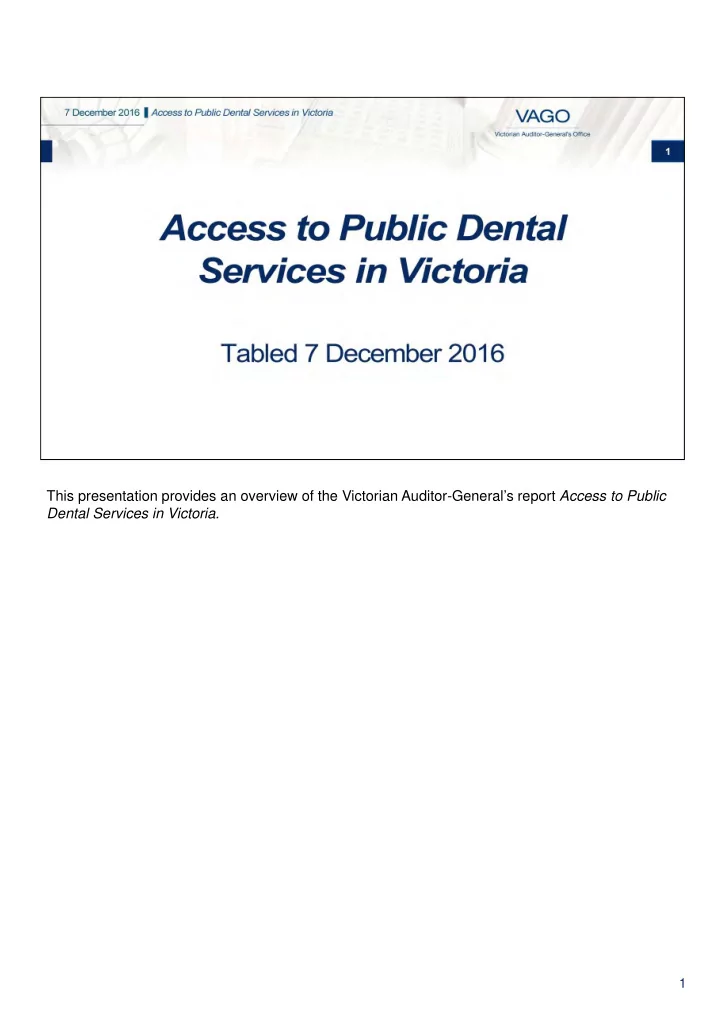

This presentation provides an overview of the Victorian Auditor-General’s report Access to Public Dental Services in Victoria. 1
Poor oral health has a significant impact on people, the health system and society as a whole. Most oral diseases are preventable. The public dental system has an important role in providing care to improve the oral health outcomes of people eligible for public dental services. Economically and socially disadvantaged Victorians, who are eligible for public dental services, are most likely to experience poor oral health. 2
We looked at whether people eligible for public dental services can access oral health care that meets their needs. We also assessed whether public dental services can be accessed easily and whether agencies are effectively helping eligible people to access services when they need them. 3
We looked at the Department of Health & Human Services (the department) and Dental Health Services Victoria (DHSV)—the two main entities responsible for preventive oral health care and promoting oral health. We also looked at access to the broad continuum of care provided by community dental agencies (CDA), which usually provide services through public hospitals or community health services. 4
Under two National Partnership Agreements, the Commonwealth Government contributed funds to reduce waiting lists. To receive the funding, states had to meet agreed output targets. The public dental sector relies on this funding to meet demand. However, the uncertain and time- limited nature of these funds makes it more difficult for the department, DHSV and CDAs to plan strategically and may mean increased demand for services will not be matched by increased funding. 5
The department and DHSV deliver preventive oral health care and promote oral health in many ways, such as adding fluoride to public water supplies to help prevent tooth decay in the population as a whole. CDAs have been able to carry out oral health promotion activities only when these have been a local priority supported by adequate resources. In its new strategic plan for 2016 − 21, DHSV has committed to developing new models of care that ‘support the right interventions at the right time at the right place’. 6
DHSV and CDAs have limited ability to introduce a more preventive approach to care. Three reasons for this are: • The funding model encourages complex and time-intensive treatment instead of focusing on getting the best outcomes for patients. • The dental care workforce has more dentists than other oral health practitioners. Using dentists rather than other oral health practitioners is not cost-effective in delivering preventive activities, such as helping patients to better manage their oral health. • Oral health and general health services are not coordinated effectively. The department and DHSV need to provide strategic leadership and planning to move to a more preventive approach to care. 7
The department and DHSV have worked to increase access by targeted groups of people but have not identified specific barriers to accessing services and cannot show how they have improved oral health. However, initiatives by DHSV and CDAs resulted in a large increase in access by priority groups since 2012–13. In its Strategic Plan, DHSV commits to: • identifying barriers to access • introducing strategies to overcome such barriers • collaborating with CDAs to find ways to improve how they work. However, this does not address the need to measure whether such strategies improve outcomes for patients. 8
We assessed how the department and DHSV monitor and report on accessibility. We found that they cannot show whether the delivery of public dental services: • improves oral health outcomes • or reduces inequalities in oral health. Current performance monitoring and reporting on the delivery of public dental services focuses on outputs and lacks indicators for improved oral health outcomes. The department and DHSV are working to identify future outcome measures that could address this gap. In its Strategic Plan for 2016–21, DHSV states that it will prepare agreements with CDAs that outline performance targets to improve health outcomes. 9
We made 11 recommendations to the department and DHSV to make changes that will: • address the imbalance between treatment and preventive efforts • increase understanding of oral health outcomes by improving indicators and reporting requirements. 10
For further information, please see the full report of this audit on our website, www.audit.vic.gov.au. 11
Recommend
More recommend